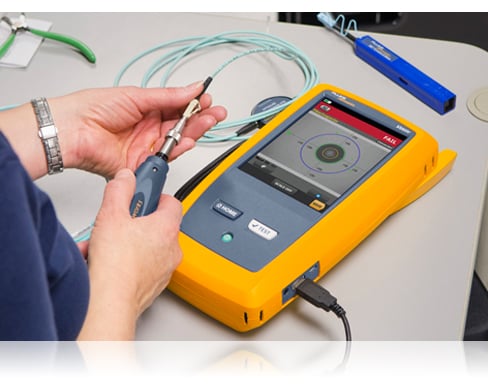The use of ofda enhances fibre evaluation with advanced optical technology.
Discover the Significance of Optical Fiber Screening in Modern Telecom
In the world of modern-day telecoms, the value of optical fibre screening can not be overstated, as it functions as the foundation for ensuring network reliability and efficiency. By carrying out regular screening procedures, operators can preemptively recognize prospective issues such as signal deterioration, hence guarding versus disruptions that could confirm expensive. Advanced strategies like Optical Time-Domain Reflectometry play a pivotal duty in this process, yet lots of may ignore the wider ramifications of these practices. What are the certain advantages that routine testing deals, and exactly how might it form the future landscape of telecommunications?

Comprehending Optical Fiber Testing
Optical fiber screening is a vital process in telecommunications that makes certain the integrity and performance of fibre optic networks. This screening incorporates a variety of treatments developed to evaluate the physical and practical attributes of optical fibers - optical fibre diameter analyser. Key parameters assessed consist of optical power loss, bandwidth capability, and mistake location, which are important for maintaining top quality communication links
The screening process usually includes making use of customized equipment such as Optical Time-Domain Reflectometers (OTDR) and Optical Power Meters. OTDRs are employed to determine and identify faults, mates, and connectors within the fiber, while power meters determine the transmitted light signal toughness to establish performance.
Additionally, screening is performed at numerous phases, consisting of throughout installment, upkeep, and troubleshooting, to ensure that the network fulfills industry standards and operational requirements. Conformity with criteria set by companies like the International Telecommunication Union (ITU) and the Telecommunications Sector Organization (TIA) is vital.
Advantages of Normal Checking
Normal screening of optical fibers yields many advantages that substantially enhance network dependability and performance. One of the key advantages is the very early detection of possible problems, such as breaks or destruction in the fibre, which can result in expensive downtime if left unaddressed (optical fibre testing equipment). By identifying these issues proactively, telecoms providers can decrease solution disturbances and ensure consistent connectivity for their consumers
In addition, normal screening assists to maintain the stability of signal top quality. As optical fibres age, their performance can be influenced by variables such as environmental problems and physical anxiety. Routine assessments allow for the tracking of signal loss and total transmission efficiency, making sure that the network runs at optimal levels.
One more significant benefit is compliance with sector requirements. Routine screening sustains adherence to governing requirements, consequently minimizing lawful and financial risks connected with non-compliance. In addition, it enhances the general life expectancy of the fiber facilities by helping with prompt maintenance and repair work.

Common Examining Techniques
Testing optical fibres utilizes various methods to make sure the integrity and performance of telecoms networks. Amongst the most usual methods is Optical Time Domain Name Reflectometry (OTDR), which assesses the entire length of the fibre by sending out a pulse of light and determining the representations triggered by blemishes or breaks. This approach provides thorough information about the area and intensity of faults.
An additional common method is the usage of Optical Power Meters, which measure the quantity of light transferred through the fibre. This method assists identify the loss of signal strength, making certain that it meets sector standards. Furthermore, Aesthetic Mistake Locators (VFL) are utilized to identify breaks or severe bends in the fibre by predicting a noticeable laser light right into the cord.
Insertion loss screening is also essential, as it evaluates the loss of signal power arising from connections and splices within the network. The use of Polarization Setting Diffusion (PMD) testing evaluates the impact of fibre qualities on signal honesty.
Each of these techniques plays an essential duty in maintaining the performance and dependability of optical fiber networks, eventually adding to smooth telecommunications operations.
Effect On Network Efficiency
The integrity and efficiency of optical go now fiber networks directly influence total network efficiency. In modern-day telecoms, the performance of data transmission counts heavily on the high quality of the optical fibres utilized. Any kind of degradation in the fiber's condition-- whether because of physical damage, contamination, or excessive flexing-- can result in enhanced attenuation and signal loss, considerably affecting data integrity and speed.
Routine optical fiber screening is vital to determine and rectify prospective issues before they manifest as network failures or slowdowns. Methods such as Optical Time Domain Reflectometry (OTDR) and insertion loss testing enable technicians to gauge the efficiency of fibre links accurately. These examinations not just evaluate the physical problem of the fibers yet also make certain conformity with market standards, thereby safeguarding the network's dependability.
Moreover, a well-maintained optical fibre network contributes to lowered functional expenses and boosted consumer fulfillment, as end-users experience less interruptions and higher information rates. Inevitably, the focus on strenuous optical fiber screening methods functions as a cornerstone for maintaining durable telecoms facilities, guaranteeing that service suppliers can meet the growing demands for transmission capacity and connectivity in today's digital age.
Future Patterns in Examining
As we look in advance, innovations in technology are positioned to reshape optical fiber testing in telecoms. The rise of automation and expert system (AI) is anticipated to improve the effectiveness and precision of screening procedures. Automated screening systems can conduct comprehensive analyses with very little human treatment, dramatically decreasing the potential for errors and speeding up time-to-deployment.
Moreover, the combination of equipment learning algorithms will certainly make it possible for predictive upkeep, allowing network suppliers to foresee possible concerns prior to they intensify right into failings. This aggressive approach not only enhances network dependability but likewise enhances functional expenses.
One more emerging fad is the development of portable testing tools that provide real-time analysis - fibre testing equipment. These tools will certainly equip professionals to do on-site diagnostics rapidly, facilitating quicker resolutions and boosting solution top quality
The development of 5G networks better requires the development of screening methodologies. As data transfer demands increase, conventional testing techniques may no longer are sufficient. Ingenious options such as optical time-domain reflectometry (OTDR) and advanced spectral evaluation will become crucial in making certain the honesty and efficiency of high-speed connections.

Verdict
Finally, optical fiber Full Article screening is crucial for making sure the honesty and integrity of contemporary telecoms networks. Regular screening techniques not just help determine prospective problems such as click here now signal loss and mistakes but also add to enhanced network performance and customer satisfaction. As the demand for seamless connectivity remains to expand, the adoption of innovative screening techniques will play a critical function in preserving high-quality network criteria and sustaining the developing landscape of telecommunications.